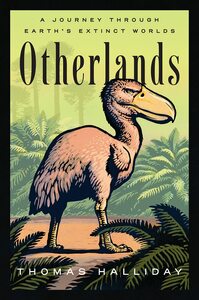Take a photo of a barcode or cover
adventurous
informative
reflective
medium-paced
Incredible read that tries to put the history, scale, and duration of extinct ecosystems into comprehensible narratives.
Snapshots of complete, living ecosystems, moving backwards through the course of deep time. It's an approach that does a lot to contextualize deep time: how significant is both the timescale and the degree to which Earth has changed over the eons. ...But I would have liked it better as a CGI nature documentary. Yes, this has a lot more depth. But (and blame it maybe on my aphantasia) I struggled a little to immerse myself; the descriptions are strong, nuanced, clear, evocative, and yet so easy to tune out. Thus some of my appreciation is theoretical, but I still liked this.
challenging
hopeful
informative
reflective
medium-paced
challenging
informative
slow-paced
Os livros "The Chaos Machine: The Inside Story of How Social Media Rewired Our Minds and Our World" (2022) e "Otherlands: A Journey Through Earth's Extinct Worlds" (2022) não têm qualquer relação entre si, mas se os juntei neste texto foi porque de formas opostas ambos quebraram uma regra básica da comunicação humana, a definição da audência para quem queriam falar. O primeiro pretende falar sobre um fenómeno novo, mas apresenta informação que qualquer pessoa minimamente interessada no tema já possui. O segundo pretende apresentar uma nova perspectiva sobre uma realidade distante da atualidade, mas não contextualiza a realidade distante, deixando o assunto à mercê apenas de quem estuda o tema.
continua no blog:
https://virtual-illusion.blogspot.com/2023/04/um-problema-de-comunicacao.html
continua no blog:
https://virtual-illusion.blogspot.com/2023/04/um-problema-de-comunicacao.html
emotional
hopeful
informative
inspiring
reflective
relaxing
medium-paced
A beautifully-written dive into deep time, revealing worlds as alien as any we could imagine, and celebrating the resilience and majesty of Earth.
challenging
informative
inspiring
reflective
medium-paced
An incredible piece of narrative non-fiction. It brings scientific writing to an approachable place. The chapters told stories through deep time that were engaging yet easy to follow. I learned so many new things and enjoyed myself so much. It took me a while to finish as I was using it as my non-fiction cleanser while reading fantasy books but I do feel as though I could’ve read it straight through as well. It is perfectly suited for either style. I loved this book and will be recommending it to anyone who enjoys anthropology.
challenging
informative
slow-paced
Note that the sheer number of references in this book has it ending at 74%.
Very conflicted about how to rate this book. I loved the beginning chapters that were closer to now where I could easily visualise the scenes he was describing.
But then the remaining chapters - which felt like most of the book though I don't know for sure - are the most a book has ever made me sleepy. It's been very tough going.
And then the final chapter picks it up again nicely in a way that made me remember how much I enjoyed the start.
Perhaps more pictures could've made it better? Most I agery to explain what I was supposed to be visualising in the furthest times discussed where I just couldn't grasp what he was trying to describe?
Or perhaps I'd just rather have read a book that covered the initial sections even further as those are the parts I really enjoyed.
Certainly conflicted about this one.
Very conflicted about how to rate this book. I loved the beginning chapters that were closer to now where I could easily visualise the scenes he was describing.
But then the remaining chapters - which felt like most of the book though I don't know for sure - are the most a book has ever made me sleepy. It's been very tough going.
And then the final chapter picks it up again nicely in a way that made me remember how much I enjoyed the start.
Perhaps more pictures could've made it better? Most I agery to explain what I was supposed to be visualising in the furthest times discussed where I just couldn't grasp what he was trying to describe?
Or perhaps I'd just rather have read a book that covered the initial sections even further as those are the parts I really enjoyed.
Certainly conflicted about this one.
Otherlands read like a crash course in palaeontology. It’s packed with explanations of the history of life and how we came into being. Quoting from the poem loving like an existentialist by [a:Savannah Brown|14941662|Savannah Brown|https://images.gr-assets.com/authors/1588893448p2/14941662.jpg]: There are many theories as to how we came to be/ and I’m not sure which one I believe. Thomas Halliday himself likens his explanation to reading an excerpt that happens to be the last chapter of a novel. We might guess the developments of the story, the plots, and the characters, yet never get the whole picture of what the real stories might be. But at least, reconstructing the story could give us an impression of how much the world has changed since it came to be and the diverse types of creatures that inhabited it before humans.
I’m pretty sure this book was written by the author with climate change in mind. Climate change might be the most important war of the twenty-first century, to achieve a balance called “net-zero” between the greenhouse gases put into the atmosphere and those taken out by 2050. Otherlands describes factual changes in the earth’s climate and its inhabitants throughout the millions of years of its history. One thing being emphasized is that the temperature did change in the past. The author argues that change is inevitable, but never on a scale as rapidly as the change that occurred after the Industrial Revolution. However, I am under the impression that human extinction is something given, as happened to many other species that we only know now through their fossilized remains. But we, as humans, have the liberty to choose to mitigate the climate issues and prolong our existence due to our collective knowledge and ability to coordinate.
The author also makes points that the shape of the continents keeps changing through time. Even now, the continents are moving. Within those continents are the entire ecosystems within them. Different ecosystems that exist within different continents might not be easy to replicate in case of the extinction of some species, due to – let’s say – climate change. On this, the author emphasized that climate change did occur in the past and it might occur again on a rapid scale. But the changes in climate in the past always gave rise to something entirely new on top of the earth, with new ecosystems and new creatures adjusted to the new temperature. The process also occurred at a slow pace that could take thousands or millions of years. And this is why climate change is the pressing issue of today.
Otherlands could be read as an intersection between biology and history. Instead of using archives, palaeontologists use fossils and geochemical evidence to determine the trace of the earth’s history. The illustrations of now-extinct creatures included in this book are merely approximations of their physical appearance, but their fossilized remains could become a testament to the cycle of life and death throughout the ages. Perhaps humans should go extinct, perhaps humans should inhabit the earth for longer, both sides of the story are arguable. But if humans collectively want to prolong their existence, palaeontology could teach us that we need to set a condition for the earth to be habitable for our species, and that involves mitigating climate change.
I’m pretty sure this book was written by the author with climate change in mind. Climate change might be the most important war of the twenty-first century, to achieve a balance called “net-zero” between the greenhouse gases put into the atmosphere and those taken out by 2050. Otherlands describes factual changes in the earth’s climate and its inhabitants throughout the millions of years of its history. One thing being emphasized is that the temperature did change in the past. The author argues that change is inevitable, but never on a scale as rapidly as the change that occurred after the Industrial Revolution. However, I am under the impression that human extinction is something given, as happened to many other species that we only know now through their fossilized remains. But we, as humans, have the liberty to choose to mitigate the climate issues and prolong our existence due to our collective knowledge and ability to coordinate.
The author also makes points that the shape of the continents keeps changing through time. Even now, the continents are moving. Within those continents are the entire ecosystems within them. Different ecosystems that exist within different continents might not be easy to replicate in case of the extinction of some species, due to – let’s say – climate change. On this, the author emphasized that climate change did occur in the past and it might occur again on a rapid scale. But the changes in climate in the past always gave rise to something entirely new on top of the earth, with new ecosystems and new creatures adjusted to the new temperature. The process also occurred at a slow pace that could take thousands or millions of years. And this is why climate change is the pressing issue of today.
Otherlands could be read as an intersection between biology and history. Instead of using archives, palaeontologists use fossils and geochemical evidence to determine the trace of the earth’s history. The illustrations of now-extinct creatures included in this book are merely approximations of their physical appearance, but their fossilized remains could become a testament to the cycle of life and death throughout the ages. Perhaps humans should go extinct, perhaps humans should inhabit the earth for longer, both sides of the story are arguable. But if humans collectively want to prolong their existence, palaeontology could teach us that we need to set a condition for the earth to be habitable for our species, and that involves mitigating climate change.


